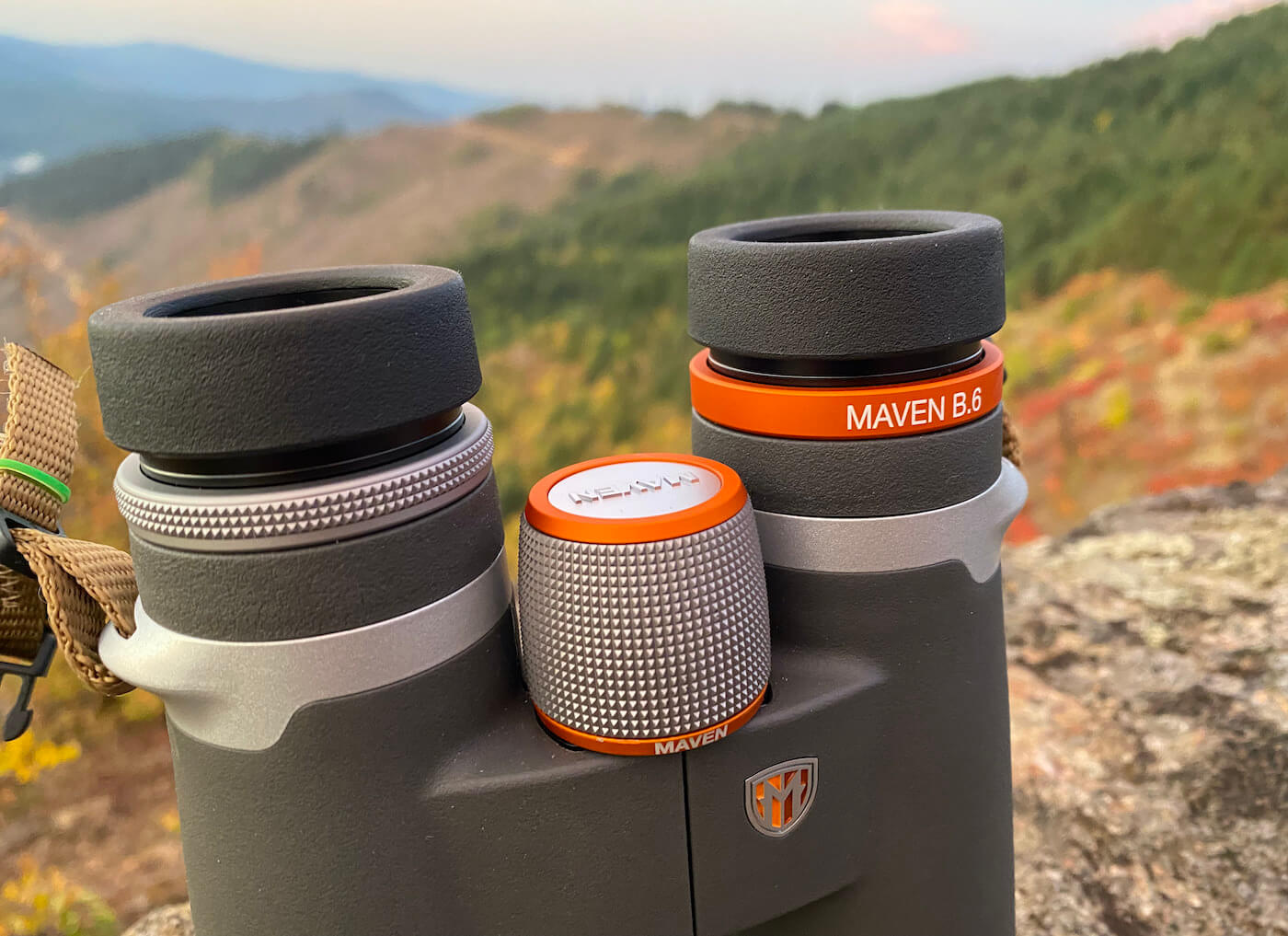The new Maven B.6 binoculars come in two options: 10×50 and 12×50. With the large 50mm objective lens, the B.6 is Maven’s brightest mid-sized binoculars. They’re designed for hunters who like to glass in the dim minutes before dawn and after sunset.
To get us a closer look, Maven sent Man Makes Fire a 12×50 review unit. After hunting with the B.6 12×50 binoculars September through November in Idaho, this is what we learned:
Maven B.6 Review: The Basics
I’ve spent some quality time hunting with previous versions of Maven binoculars, including the original B.1, the awesome new B1.2, as well as the C.1 and C.3. They’ve all been excellent with outstanding price-to-value ratios. Maven is a direct-to-consumer manufacturer, so the company keeps consumer costs down by avoiding typical retail markup.
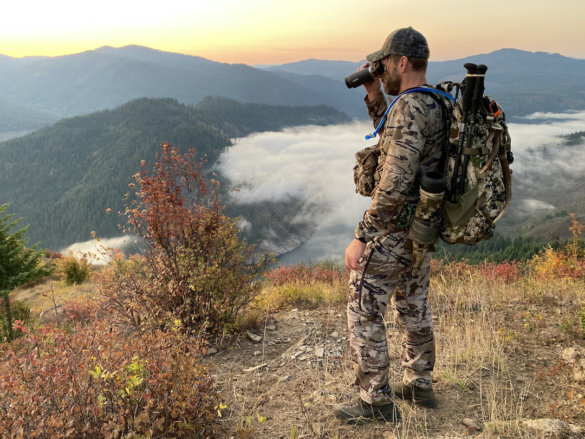
The C-series optics represent Maven’s most affordable optics: They’re priced on the low side of midrange pricing but compete well with binoculars that cost more. Maven’s B-series binoculars are priced on the low side of high-end pricing but compete very well with binoculars that cost significantly more.
Maven’s B-series binoculars use Japanese-made extra-low dispersion ED glass. As you would expect, the lenses are fully multi-coated. Maven’s optical quality is bright and crisp with superb color fidelity. I tend to see Maven’s images as more on the white end of the scale — they don’t have a warm tinge, and yet the color still pops nicely.
Each unit is waterproof and fog proof. The frames are made from rugged magnesium and they have a grippy rubber housing. They feel solid and well-balanced in the hand — simple but effective ergonomics.
Maven B-series binoculars are assembled in America, which also lets the company deliver cool customizations. The overall fit and finish is excellent.
The B.6 Design: Why Choose an x50?
The whole point of offering a 10×50 or 12×50 binocular is to deliver improved light transmission via the larger 50mm objective lens. If you agree that 10×42 binoculars are a great all-around binocular size that’s effective for a wide range of hunting, birding, and recreational use, then 10×50 binoculars must be better, right?
Yes. Sort of. Not always.
Because 10x50s have larger 50mm objective lenses compared to 10×42’s 42mm objective lenses, a 10×50 binocular will allow more light to pass through to your eye. This means that you can see more detail in low-light conditions. In bright, sunny midday conditions, the larger lens doesn’t provide a benefit.
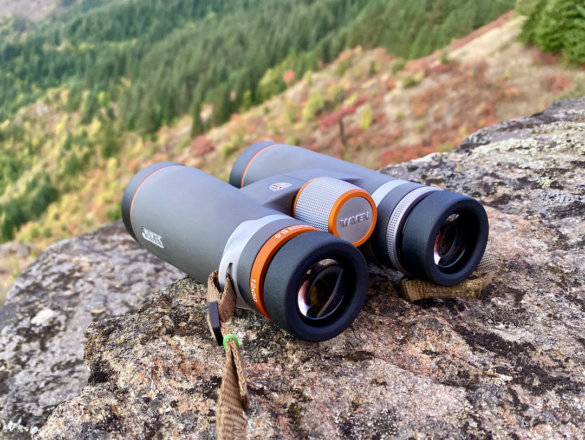
One measurement you can use to consider relative brightness is Exit Pupil. You find the exit pupil calculation by dividing the objective lens size (50) by the magnification (10). So 50 divided by 10 = 5.0. In the case of 10×42, the exit pupil is 4.2. Exit pupil represents the diameter of the light that makes it to your eye. When it comes to exit pupil, bigger is better for low-light viewing.
Quality of Components and Construction

All of this matters most when you’re comparing apples to apples. A cheap 10×50 binocular can have worse low-light performance than a high-quality 10×42 because the quality of glass, quality of coatings, and quality of construction all come into play to affect light transmission and clarity.
However, the B1.2 and B.6 binoculars both use Japanese glass and they’re both assembled in the U.S. and they both use wide-angle Schmidt-Pecan prism designs.
Technically, a B.6 10×50 should deliver a slight boost of low-light performance over a 10×42 B1.2. So, if low-light performance is critical to you, the B.6 10×50 might be your best choice.
What About the B.6 12×50 vs the B1.2 10×42?
An interesting thing happens when you compare a 12×50 B.6 to a 10×42 B1.2: You get very similar low-light performance. In fact, it’s so close that I can’t say that I can see a light difference. Maven reports that its 12×50 B.6 has 93.8% light transmission while its B1.2 has 94.5% light transmission. (That’s a 0.7% difference with the same 4.2 exit pupil calculation.)
When I’m swapping the two binoculars back and forth while night falls . . . I can’t make out much of a difference in perceiving objects at close range or larger objects at farther distances.
However, because the 12×50 B.6 is giving me 2x more magnification I can identify a bit more detail in the last few minutes of usable light.
So the gain between the 10×42 and the 12×50 is a bit of extra magnification. Nice.
If you were able to compare a 10×50 B.6 with a 10×42 B1.2 side-by-side in very low light, after your pupils have fully dilated, you should be able to notice a slight low-light gain in the 10×50, primarily due to the increased exit pupil of 5.0 (the reported light transmission in the B.6 10×50 is just .25% better than the 10×42 B1.2).
If this seems confusing, you can think of it this way: Cut a 4.2mm hole in a piece of cardboard and place it over the business end of a flashlight. Then cut a 5mm hole in another piece of cardboard and place it over the business end of the same model of flashlight. The flashlight with the 5mm beam coming out will deliver slightly more light. In daylight, the difference won’t matter. In a deep dark cave, it might matter.
Field of View
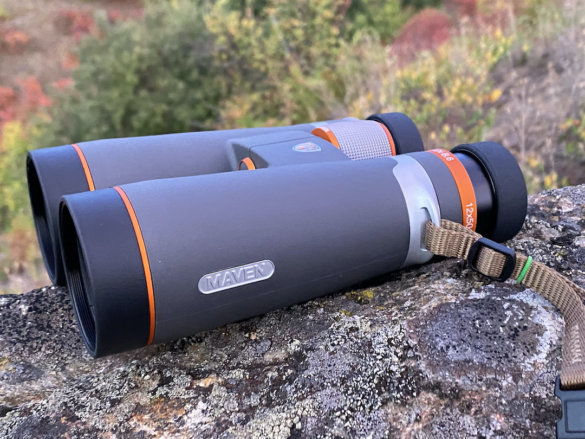
The drawback to using a 12×50 instead of a 10×42 is the decreased field of view in the x50. The 12×50 B.6 has a 289′ FOV at 1,000 yards compared to the 362′ FOV delivered by the B1.2.
While the B.6 12×50 FOV is pretty good and competitive compared to other 12×50 manufacturers, I personally appreciate the larger, more immersive image delivered by the B1.2 10×42 for the kinds of mixed terrain North Idaho hunting I do most.
Incidentally, the B.6 10×50 FOV is 341 — which is a lot closer to the B1.2 10×42’s 362′ FOV.
Want a fuller explanation of Field of View? Check out Maven’s illustrated Optics 101 guide.
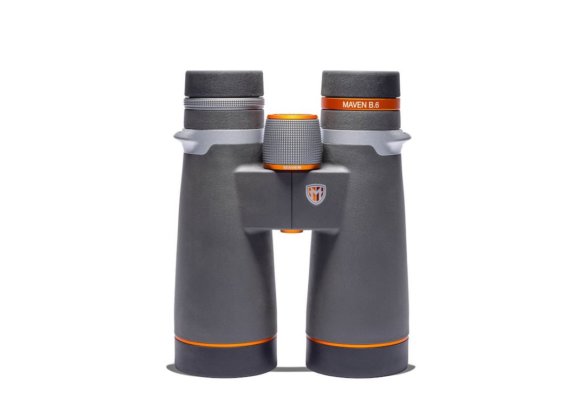
What About the Weight?
While a benefit of larger objective lenses is increased light transmission, the drawback is increased weight and size. As the objective lens gets wider, the length of the binoculars tends to increase. So x50 binoculars are usually taller and heavier than x42 binoculars.
The B.6 weighs in at 30.7 oz. That’s actually pretty good. It’s only 2.7 oz more than the Maven C.3s, which use a polymer frame material instead of the beefier magnesium in the B.6.
The B.6, however, weighs 4 oz more than the new, more compact B1.2 and is about 1″ taller.
So what’s that really mean and does it matter?
To me, it matters. Here’s why:
Low-light, Reach and Packability Balance
For me, in early morning light, all I need to do is identify if I have a shooter elk or buck. At that point, the sun will keep coming up and I’ll eventually get to legal shooting light — either with a game plan or a shot.
Because I hunt in such mixed terrain with mostly short and medium-range glassing, I rarely want the extra reach of a 12x magnification. In addition, some guys tend to perceive more shake at higher magnifications, which can make it harder to discern images even though it’s technically bigger to your eye.
If you’re sitting and propping your elbows or using a tripod, this is less of an issue.
I’m usually moving and glassing, moving and glassing, so having a lighter binocular that I can more easily handle on the go is best for me.
As it turns out, I’ve also come to appreciate bigger Field of Views. While I primarily only pay attention the middle area of the image, a bigger FOV results in a more immersive experience. I like that a lot.
For me, the B1.2 in 10×42 is an outstanding choice — and one that I can heartily recommend to any mixed-terrain, on-the-go hunter. If I tended to hunt in more wide open landscapes, particularly for mule deer, I’d probably stick with the 12×50 B.6.
Maven B6 Specifications:
| Magnification | 10x | 12x |
| Obj. Lens Diameter | 50mm | 50mm |
| Exit Pupil | 5mm | 4.2mm |
| Field of View @1,000 yds | 341′ | 289′ |
| Brightness | 25 | 17.6 |
| Light Transmission % | 94.75% | 93.80% |
| Twilight Factor | 22.4 | 24.5 |
| Weight | 30.69 oz | 30.69 oz |
| Dimension WxHxD | 5.2″ x 6.6″ x 2.3″ | 5.2″ x 6.6″ x 2.3″ |
| Eye Relief | 18.1mm | 17.5mm |
| Near Focus | 7.5′ | 7.5′ |
| Prisms Type | Wide Angle Schmidt-Pechan | Wide Angle Schmidt-Pechan |
| Prism Reflective Coating | Dielectric Coating | Dielectric Coating |
| ED Glass | Yes | Yes |
| Diopter Correction (DPT) | +/-3 | +/-5 |
| Waterproof/Pressure Testing | IPX7 (1m for 30 minutes) | IPX7 (1m for 30 minutes) |
| Functional Temp Range | -13°~140°F | -13°~140°F |
| Frame Material | Magnesium | Magnesium |
| Internal Gas Purge | Nitrogen | Nitrogen |
| Tripod Adaptable | Yes | Yes |
| Country of Origin | Japanese components, assembled in the U.S. | Japanese components, assembled in the U.S. |
Chromatic Aberrations
I can spot a bit of chromatic aberration in the Maven B.6 12×50 binoculars — but I have to pay close attention and look for it on purpose in a high-contrast situation. What is a chromatic aberration? Basically, it’s when you can see a slight hue outlined around an object with sharp lines against a high-contrast, usually light background. It’s caused when different wavelengths of color don’t converge at exactly the same spot after passing through a lens.
If you want to learn more about chromatic aberration, I cover it in more depth in my Maven B1.2 10×42 binocular review.
What do you need to know now? There is a bit of chromatic aberration, but it’s quite small and very good compared to similarly priced competition. Most people will have a hard time seeing it at all.
X50 Recommendations
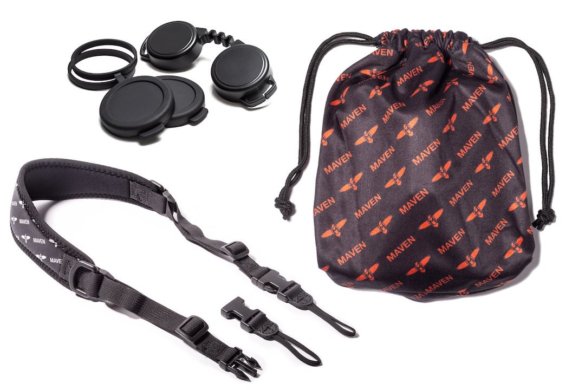
If you’re on the fence between a B.6 10×50 and a B1.2 10×42, choose the B.6 if you want an edge during the first 5 minutes of usable light or the last 5 minutes of usable light. For everything else, I recommend the smaller and lighter 10×42 B1.2 as your can’t-go-wrong choice.
If you’re thinking about a 12×50 because you want x42 light performance but with a 2x magnification boost for longer-distance glassing, the 12×50 is an excellent choice. It’s small enough to pack around but has that extra 2x reach.
Note: If you’re not on a fast hunting gift timeline, be sure to check out Maven’s Custom Optics Builder to design your own color and camo accents!
Competition & Competitive Options
There are a lot of great binocular manufacturers these days, and it’s hard to go wrong once you’re willing to invest in a midrange-to-high-end optic. If the B.6 is on your radar, these alternative options might also fit your needs:
Vortex Razor HD — The Vortex Razor HD 10×50 and 12×50 binoculars are typically sold at a similar price point compared to the Maven B.6 binoculars. They use an Abbe-Koenig prism construction that delivers a 315′ FOV in the 10×50 and 285 FOV in the 12×50. Like Maven, Vortex has an excellent no-questions-asked warranty and is an American company (but doesn’t assemble in America).
Swarovski EL 50 — The Austrian Swarovski EL series binoculars are widely recognized as the best (or nearly the best depending on the exact model and personal preferences) binoculars in the world. The key benefit is superb clarity and build quality, but the key drawback is the very expensive price point. When price is not a factor, it’s hard to beat Swarovski.
Leupold BX-5 Santiam HD — If you’re considering Maven, you’re likely interested in American optics companies. Leupold’s BX-5 series is the company’s best optics, and they’re priced competitively with Maven’s B-series line. They’re manufactured in Japan.
Maven C.3 — The Maven C.3 starts at $400 and are a great value — read my full C.3 review here. Compared to similarly priced x50 binoculars, they’re excellent, and they deliver a slight low-light boost compared to midrange 10×42 binoculars. However, when I compared the 10×50 to the higher-end glass in the B1.2 10×42, I could not discern a significant low-light gain. There’s nothing wrong with the C.3 here, it’s just that the exceptional quality of the B1.2 shines through.
The Verdict: Another B-Series Winner
As 10×50 and 12×50 binoculars become increasingly common and popular, they illustrate a key choice between benefits and drawbacks, particularly when compared to do-it-all 10×42 binoculars. The primary benefit is a slight boost in very low-light performance. The primary drawback is increased size, increased weight, and decreased Field of View. However, that’s not the end of the story. The x50 represents a lighter, more compact answer when you’re questioning the size and weight of 10×56, 12×56, and 15×56 binoculars for longer-range glassing (as in Maven’s B.5 line). At a certain point, all of theses options bring in spotting scopes, in which case you might want 8x42s in your chest pack with a spotting scope in your backpack. No matter what, choose the best glass you can afford. And if the new Maven B.6 is in your budget, you’ll probably appreciate them. Very highly recommended.

